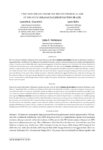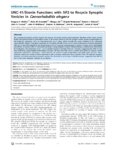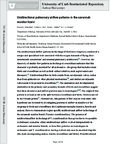|
|
Creator | Title | Description | Subject | Date |
| 576 |
 |
Bastiani, Michael; Bandyopadhyay, Pradip K.; Olivera, Baldomero M.; Golic, Kent G. | Targeted mutagenesis by homologous recombination in D. melanogaster | We used a recently developed method to produce mutant alleles of five endogenous Drosophila genes, including the homolog of the p53 tumor suppressor. Transgenic expression of the FLP site-specific recombinase and the I-SceI endonuclease generates extrachromosomal linear DNA molecules in vivo. | Mutations; Drosophila; Gene targeting | 2002 |
| 577 |
 |
Capecchi, Mario R. | Targeted mutations in hoxa-9 and hoxb-9 reveal synergistic interactions. | Mice were generated with a targeted disruption of the homeobox-containing gene hoxb-9. Mice homozygous for this mutation show defects in the development of the first and second ribs. In most cases the first and second ribs are fused near the point at which the first and second pairs of ribs normally... | Embryonic and Fetal Development; In Situ Hybridization; Mice, Knockout | 1997-01-15 |
| 578 |
 |
Capecchi, Mario R.; Bernstein, Kenneth E.; Thomas, Kirk R. | Targeting genes for self-excision in the germ line | A procedure is described that directs the self-induced deletion of DNA sequences as they pass through the male germ line of mice. The testes-specific promoter from the angiotensin-converting enzyme gene was used to drive expression of the Cre-recombinase gene. Cre was linked to the selectable marker... | Cre-recombinase; Hoxa3; Chimeric mice | 1999-06-15 |
| 579 |
 |
Beckerle, Mary C. | Targeting of zyxin to sites of actin membrane interaction and to the nucleus | The localization of proteins to particular intracellular compartments often regulates their functions. Zyxin is a LIM protein found prominently at sites of cell adhesion, faintly in leading lamellipodia, and transiently in cell nuclei. Here we have performed a domain analysis to identify regions in ... | Zyxin; Actin; LIM domains; Focal adhesions; Lamellipodia; Cytoskeletal architecture | 2001 |
| 580 |
 |
Clayton, Dale H. | Testing species limits of non-echolocating Philippine swiftlets (Collocalia spp.) using molecular genetic data | Swiftlets are small, insectivorous birds that are distributed from the Indian Ocean, through southeast Asia and north Australia, to the Pacific. About 22 species of swiflets nest in caves or other dark places, where they navigate using a crude form of echolocation (Chantler and Driessens 1995). Thr... | | 2000 |
| 581 |
 |
Bohs, Lynn A. | Three-gene phylogeny of the genus Solanum (Solanaceae) | Solanum, with approximately 1,500 species, is the largest genus in the Solanaceae and includes economically important species such as the tomato, potato, and eggplant. In part due to its large size and tropical center of diversity, resolving evolutionary relationships across Solanum as a whole has ... | ndhF; trnT-F; Waxy; Solanum; Cyphomandra | 2007 |
| 582 |
 |
Baehr, Wolfgang | Tissue-specific expression in transgenic mice directed by the 5'-flanking sequences of the human gene encoding interphotoreceptor retinoid-binding protein | Interphotoreceptor retinoid-binding protein (IRBP) is an extracellular protein that has been suggested to participate in the visual process as a carrier for visual retinoids. A chimeric gene composed of the human IRBP promoter fused to the bacterial reporter gene chloramphenicol acetyltransferase (C... | Restriction Mapping; Nucleic Acid Hybridization; Mice; Gene Expression | 1990-05-25 |
| 583 |
 |
Goller, Franz | Tracheal length changes and upper vocal tract resonances during zebra finch song | Upper vocal tract resonances in singing birds could be modified by beak opening, laryngeal adjustments and tracheal length changes. | Sonomicrometry; Syringeal; Tracheal shortening | 2000 |
| 584 |
 |
Ehleringer, James R. | Tracing changes in ecosystem function under elevated carbon dioxide conditions | Responses of ecosystems to elevated levels of atmospheric carbon dioxide (CO2) remain a critical uncertainty in global change research. Two key unknown factors are the fate of carbon newly incorporated by photosynthesis into various pools within the ecosystem and the extent to which elevated CO2 is... | Elevated carbon dioxide; Stable isotopes; Radiocarbon; Global change; Terrestrial ecosystems | 2003 |
| 585 |
 |
Bohs, Lynn A. | Transfer of Cyphomandra (Solanaceae) and its species to Solanum | Data from recent molecular studies demonstrate that the genus Cyphomandra is nested within Solanum. Recognition of Cyphomandra as a separate genus therefore is not tenable unless Solanum is broken up into smaller monophyletic units. All Cyphomandra species are transferred to Solanum, necessitating t... | Cyphomandra; Solanum | 1995 |
| 586 |
 |
Gesteland, Raymond F. | Translation of Rl7 RNA fragments | Examination of the events during infection of cells by RNA phages reveals phemonomena that are surprisingly complex for a virus that has only enough information to code for three to four proteins. The coat protein is synthesized at a rapid rate through most of the infectious cycle making it the pre... | Electrophoresis; RNA, Messenger; Peptide Biosynthesis; Kinetics | 1969 |
| 587 |
 |
Hultine, Kevin; Sperry, John S. | Transpiration and hydraulic strategies in a piñon-juniper woodland | Anthropogenic climate change is likely to alter the patterns of moisture availability globally. The consequences of these changes on species distributions and ecosystem function are largely unknown, but possibly predictable based on key ecophysiological differences among currently coexisting species... | Drought; Hydraulic transport model; Juniperus osteosperma; Plant water use; Sap flux; Species distributions | 2008 |
| 588 |
 |
Jorgensen, Erik | Trio's Rho-specific GEF domain is the missing Gaq effector in C. elegans | The Gaq pathway is essential for animal life and is a central pathway for driving locomotion, egg laying, and growth in Caenorhcibditis elegans, where it exerts its effects through EGL-8 (phospholipase CB [PLCB]) and at least one other effector. To find the missing effector, we performed forward ... | | 2007-11-01 |
| 589 |
 |
Coley, Phyllis D. | Tritrophic interactions in tropical versus temperate communities | The latitudinal gradient in diversity is one of the oldest (e.g., Wallace, 1878) and most obvious trends in ecology, and a wealth of literature is devoted to understanding both the causes and consequences of this gradient (Dobzhansky, 1950; also reviewed by Rohde, 1992). Given the enormous latitudi... | Tritrophic interactions; Trophic cascades; Herbivory; Tropical communities; Temperate communities | 2002 |
| 590 |
 |
Davidson, Diane W. | Tropical arboreal ants: why so abundant? | ANTS ARE AMONG the most numerous and readily observed arthropods of tropical forests. Indeed, based on their standing biomass and many effects on other species, ants (Formicidae) are arguably the dominant arthropod family in the canopies of lowland rain forest trees (Tobin 1995). Others have tried t... | Arboreal ants; Tropics | 1996 |
| 591 |
 |
Shapiro, Michael D. | Turnover of sex chromosomes in the stickleback fishes (Gastrosteidae) | Diverse sex-chromosome systems are found in vertebrates, particularly in teleost fishes, where different systems can be found in closely related species. Several mechanisms have been proposed for the rapid turnover of sex chromosomes, including the transposition of an existing sex-determination gen... | Sex determination; Gasterosteus aculeatus; Gasterosteus wheatlandi; Pungitius pungitius; Culaea inconstans; Apeltes quadracus; Gasterosteidae | 2009-02-20 |
| 592 |
 |
Beckerle, Mary C. | Two muscle-specific LIM proteins in Drosophila | The LIM domain defines a zinc-binding motif found in a growing number of eukaryotic proteins that regulate cell growth and differentiation during development. Members of the cysteine-rich protein (CRP) family of LIM proteins have been implicated in muscle differentiation in vertebrates. Here we r... | LIM domains; Mlp60A; Mlp84B; Cysteine-rich proteins | 1996 |
| 593 |
 |
Bohs, Lynn A. | Two new species from the brevantherum clade of solanum (solanaceae) from eastern Brazil | Two new species of Solanum (Solanaceae) from eastern Brazil are described. Solanum anisocladum Giacomin & Stehmann is similar to S. megalochiton Mart., but differs by the indument of the adaxial leaf surface, which is composed of long porrect-stellate and unbranched trichomes. It also has a more rob... | | 2013-01-01 |
| 594 |
 |
Clayton, Dale H. | Two new species of Dennyus (Collodennyus) chewing lice (Phthiraptera: Amblycera: Menoponidae) from swiftlets (Apodiformes: Apodidae) | The new species Dennyus (Collodennyus) mimirogerorum from the Papuan swiftlet, Aerodramus papuensis (Rand), from Papua New Guinea and D. (C.) bartoni from the Philippine swiftlet, A. mearnsi (Oberholser), from the Philippines are described and illustrated. The genetic distinctiveness of these two sp... | Collodennyus; Chewing louse; Chewing lice; Swiftlets; Phthiraptera; Papuan swiftlet; Aerodramus papuensis | 2006 |
| 595 |
 |
Clayton, Dale H. | Two new species of Dennyus (Ctenodennyus) lice (Phthiraptera: Menoponidae) from swiftlets (Apodiformes: Apodidae) | To date, only a single species of Dennyus (Ctenodennyus) has been described, this being D. (C.) spiniger Ewing from Cypseloides niger borealis (Kennedy), the northern black swift in North America. Through extensive collecting of lice by the junior author from swiftlets and through a loan of Bishop M... | Apodidae; Menoponidae; Ctenodennyus; Dennyus spiniger; Dennyus southwoodi; Dennyus elbeli | 1997 |
| 596 |
 |
Jorgensen, Erik | UNC-11, a Caenorhabditis elegans AP180 homologue, regulates the size and protein composition of synaptic vesicles | The unc-11 gene of Caenorhabditis elegans encodes multiple isoforms of a protein homologous to the mammalian brain-specific clathrin-adaptor protein AP180. The UNC-11 protein is expressed at high levels in the nervous system and at lower levels in other tissues. In neurons, UNC-11 is enriched at pr... | Caenorhabditis elegans; Synaptic vesicles; unc-11; Synaptobrevin; Endocytosis | 1999 |
| 597 |
 |
Jorgensen, Erik | UNC-41/stonin functions with AP2 to recycle synaptic vesicles in Caenorhabditis elegans | The recycling of synaptic vesicles requires the recovery of vesicle proteins and membrane. Members of the stonin protein family (Drosophila Stoned B, mammalian stonin 2) have been shown to link the synaptic vesicle protein synaptotagmin to the endocytic machinery. Here we characterize the unc-41 gen... | | 2012-01-01 |
| 598 |
 |
Farmer, Colleen G. | Unidirectional pulmonary airflow patterns in the savannah monitor lizard | The unidirectional airflow patterns in the lungs of birds have long been considered a unique and specialized trait associated with the oxygen demands of flying, their endothermic metabolism1 and unusual pulmonary architecture2,3. However, the discovery of similar flow patterns in the lungs of crocod... | | 2014-02-20 |
| 599 |
 |
Gesteland, Raymond F.; Atkins, John F.; Tuohy, Therese M. | Uninterrupted translation through putative 12-nucleotide coding gap in sequence of carA: business as usual | Previous work of others reported an untranslated stretch of 12 nucleotides in the 5' coding sequence of carA from Pseudomonas aeruginosa. However, N-terminal protein sequencing of carA-lacZ translational fusions shows that these 12 nucleotides are normally translated in a continuous triplet manner, ... | Base Sequence; Protein Biosynthesis; Sequence Deletion | 1994 |
| 600 |
 |
Olivera, Baldomero M. | Uniquely selective inhibitor of the mammalian fetal neuromuscular nicotinic acetylcholine receptor | We have purified and characterized a novel conotoxin from the venom of Conus obscurus, which has the unique property of selectively and potently inhibiting the fetal form of the mammalian neuromuscular nicotinic acetylcholine receptor (nAChR) (α1β1γδ-subunits). Although this conotoxin, αA-cono... | Conotoxins; Conus obscurus; Fetal; Muscle; nAChR; Inhibitor; Receptor | 2005-01-19 |

























